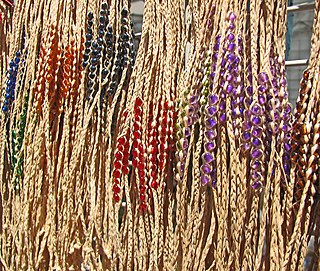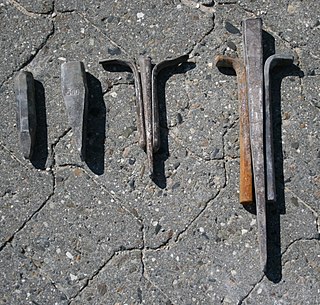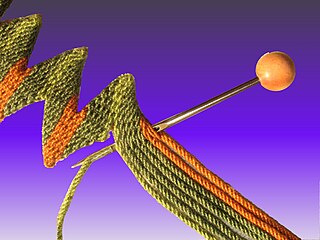
An arrow is a fin-stabilized projectile that is launched via a bow, and usually consists of a long straight stiff shaft with stabilizers called fletchings, as well as a weighty arrowhead attached to the front end, and a slot at the rear end called the nock for engaging the bowstring. The use of bows and arrows by humans predates recorded history and is common to most cultures. A craftsman who makes arrows is a fletcher, and one that makes arrowheads is an arrowsmith.

Rug making is an ancient craft, and covers a variety of techniques. Types of rug include: braided, hooking, rag rugs and woven.

A braid is a complex structure or pattern formed by interlacing three or more strands of flexible material such as textile yarns, wire, or hair. The materials used have depended on the indigenous plants and animals available in the local area. Braids have been made for thousands of years, in many different cultures around the world, for a variety of uses.

A rope is a group of yarns, plies, fibers or strands that are twisted or braided together into a larger and stronger form. Ropes have tensile strength and so can be used for dragging and lifting. Rope is thicker and stronger than similarly constructed cord, string, and twine.

A lucet is a tool used in cordmaking or braiding which is believed to date back to the Viking and Medieval periods, when it was used to create cords that were used on clothing, or to hang items from the belt. Lucet cord is square, strong, and slightly springy. It closely resembles knitted I-cord or the cord produced on a knitting spool. Lucet cord is formed by a series of loop like knots, and therefore will not unravel if cut. Unlike other braiding techniques such as kumihimo, finger-loop braiding or plaiting, where the threads are of a finite length, lucetted braids can be created without pre-measuring threads and so it is a technique suited for very long cords.

A lanyard is a cord or strap worn around the neck, shoulder, or wrist to carry such items as keys or identification cards. In the military, lanyards were used to fire an artillery piece or arm the fuze mechanism on an air-dropped bomb by pulling out a cotter pin when it leaves the aircraft. They are also used to attach a pistol to a body so that it can be dropped without being lost. Aboard a ship, it may refer to a piece of rigging used to secure or lower objects.

Macramé is a form of textile produced using knotting techniques.

Rope splicing in ropework is the forming of a semi-permanent joint between two ropes or two parts of the same rope by partly untwisting and then interweaving their strands. Splices can be used to form a stopper at the end of a line, to form a loop or an eye in a rope, or for joining two ropes together. Splices are preferred to knotted rope, since while a knot typically reduces the strength by 20–40%, a splice is capable of attaining a rope's full strength. However, splicing usually results in a thickening of the line and, if subsequently removed, leaves a distortion of the rope. Most types of splices are used on 3-strand rope, but some can be done on 12-strand or greater single-braided rope, as well as most double braids.
While a spliced 3-strand rope's strands are interwoven to create the splice, a braided rope's splice is constructed by simply pulling the rope into its jacket.
Baren (馬連、馬楝) listen (help·info) is a disk-like hand tool with a flat bottom and a knotted handle used in Japanese woodblock printing. It is used to burnish the back of a sheet of paper, lifting ink from the block.

A fid is a conical tool traditionally made of wood or bone. It is used to work with rope and canvas in marlinespike seamanship. A fid differs from a marlinspike in material and purposes. A marlinspike is used in working with wire rope, natural and synthetic lines, may be used to open shackles, and is made of metal. A fid is used to hold open knots and holes in canvas, and to separate the "lays" of synthetic or natural rope for splicing. A variation of the fid, the gripfid, is used for ply-split braiding. It adds a jamming cleat to pull a cord back through the cord split by the fid's point.

The eye splice is a method of creating a permanent loop in the end of a rope by means of rope splicing.

A friendship bracelet is a decorative bracelet given by one person to another as a symbol of friendship. Friendship bracelets are often handmade, usually of embroidery floss or thread and are a type of macrame. There are various styles and patterns, but most are based on the same simple half-hitch knot. They resemble a friendship that is strong and everlasting. If one were to remove the bracelet it resembles that the friendship has ended. (over) The only proper way for a bracelet to come off is by natural wear and tear and to eventually fray enough to fall of.

Cable lacing is a method for tying wiring harnesses and cable looms, traditionally used in telecommunication, naval, and aerospace applications. This old cable management technique, taught to generations of linemen, is still used in some modern applications since it does not create obstructions along the length of the cable, avoiding the handling problems of cables groomed by plastic or hook-and-loop cable ties.

Hemp jewelry uses hemp twine material which is made from the Cannabis sativa plant, otherwise known as “Common Hemp”, which is cultivated to make goods such as food, fuel, clothing and textiles, cosmetics, paints, paper, building materials, and plastics, among others. Some types of hemp jewelry include bracelets, necklaces, anklets, rings, watches, masks, purses, and other adornments. The jewelry can also make use of other materials, such as glass, wood, bones, rocks, or gems.

Plug and feather, also known as plugs and wedges, feather and wedges, wedges and shims, pins and feathers and feather and tare, refers to a technique and a three-piece tool set used to split stone.

A cleaving axe or cleaver is a form of axe used within green woodworking to split wood lengthways. Cleaving (riving) is used to turn a log into lumber or billets into firewood. Splitting axe is sometimes described as an old name for a splitting maul or froe.

Ply-split braiding is a technique where one twisted cord ("splitter") passes through another twisted cord or cords splitting the plies of the latter cords. This is unlike weaving or many forms of braiding where cloth is formed by threads interlacing in an over-under sequence. Pattern is formed by cord color, and splitting order.

Wood splitting is an ancient technique used in carpentry to make lumber for making wooden objects, some basket weaving, and to make firewood. Unlike wood sawing, the wood is split along the grain using tools such as a hammer and wedges, splitting maul, cleaving axe, side knife, or froe.

In mathematics Alexander's theorem states that every knot or link can be represented as a closed braid; that is, a braid in which the corresponding ends of the strings are connected in pairs. The theorem is named after James Waddell Alexander II, who published a proof in 1923.

String is a long flexible structure made from fibers twisted together into a single strand, or from multiple such strands which are in turn twisted together. String is used to tie, bind, or hang other objects. It is also used as a material to make things, such as textiles, and in arts and crafts. String is a simple tool, and its use by humans is known to have been developed tens of thousands of years ago. In Mesoamerica, for example, string was invented some 20,000 to 30,000 years ago, and was made by twisting plant fibers together. String may also be a component in other tools, and in devices as diverse as weapons, musical instruments, and toys.



















